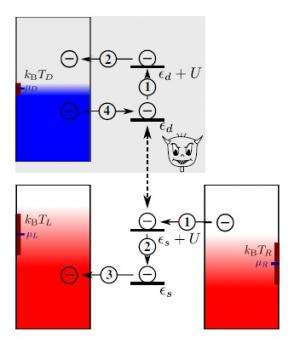February 1, 2013 feature
Scientists propose creating Maxwell's demon with two quantum dots

(Phys.org)—When you open your door on a cold winter day, the warm air from your home and the cold air from outside begin to mix and evolve toward thermal equilibrium, a state of complete entropy where the temperatures outside and inside are the same. This situation is a rough example of the second law of thermodynamics, which says that entropy in a closed system never decreases. If you could control the air flow in a way that uses a sufficiently small amount of energy, so that the entropy of the system actually decreases overall, you would have a hypothetical mechanism called Maxwell's demon.
Maxwell's demon is named after the physicist James Clerk Maxwell, who first considered the idea in the 1800s. He proposed that the demon would act as a doorman, allowing only hot (fast-moving) molecules to go one way and cold (slow-moving) molecules to go the other way. Theoretically, the demon would be able to heat a hot reservoir and cool down a cold reservoir. As long as the demon uses a sufficiently small amount of energy, the entropy that it creates will be less than the entropy of the system that it lowers. As a result, Maxwell's demon violates the second law of thermodynamics.
So far, scientists have not been able to physically create Maxwell's demon, at least not without increasing more entropy elsewhere. However, they have been trying numerous approaches, especially in the last decade.
In a new study, Philipp Strasberg at the Institute of Technology in Berlin, and coauthors have proposed that Maxwell's demon can be physically implemented with two interacting quantum dots connected to thermal reservoirs, where one dot takes the role of the demon and the other that of the controlled system. The experiment doesn't violate the second law of thermodynamics, but it provides a very simple, minimalist implementation of the demon.
"To the best of our knowledge, our work provides for the first time a complete thermodynamic description of a minimalistic Maxwell demon," coauthor Massimiliano Esposito at the University of Luxembourg told Phys.org. "We rigorously quantify the action of the Maxwell demon on the system by identifying the information flux that he is generating. But we also clearly demonstrate that when the entropy production needed to implement the Maxwell demon mechanism is taken into account, the second law for the system together with the demon is recovered."
In other words, entropy does increase somewhere, but not in the first quantum dot alone.
"As a whole, the combined system (including the demon) is just a thermoelectric device where thermal gradients are used to generate an electric current," Esposito said. "As such, it does of course respect the thermodynamics, i.e., its total entropy is always increasing. However, if the part of the system implementing the demon is disregarded, everything looks as if the remaining part of the system was subjected to a Maxwell demon breaking the second law while keeping the first one intact."
In their proposed experiment, the scientists coupled one dot to two reservoirs, which acts as a single-electron transistor, and coupled the second dot to another reservoir. The physicists showed that the second dot can be tuned to detect the transistor's state, which is either empty (0) or filled (1). In order to do this, the two dots must be perfectly correlated, so that when the first dot (transistor) gets filled up, the second dot (detector) gets emptied, and vice versa. When the detector performs an infinitely fast and precise feedback, then the system receives additional information during entropy production.
"Maxwell's demon is typically envisaged as an intelligent being performing feedback control operations on a monitored system and thereby modifying the entropy balance whilst keeping its energetics unaffected," coauthor Gernot Schaller at the Institute of Technology in Berlin said. "If it is just for the sake of sorting particles, the demon however need not be so smart such that it is possible to encode its function in a physical device.
"Due to the capacitive interaction, the demon changes its state and back-acts on the system. In its simplest operational mode, the system may thus transport electrons against a potential gradient. Since the measurement and control are performed with physical devices, our model includes an exchange of energy between demon and system. However, the modification of the system's energy balance can be made unobservably small whilst preserving a strong modification of the system's entropy production."
In the future, the researchers hope that this experiment could be realized.
"Perspectives for performing this experiment are not bad," Schaller said. "A scanning tunneling microscope could be converted into a demon device, whereas the required tunneling rates could be engineered using a more sophisticated quantum dot structure."
More information: Philipp Strasberg, et al. "Thermodynamics of a Physical Model Implementing a Maxwell Demon." Physical Review Letters 110, 040601 (2013). DOI: 10.1103/PhysRevLett.110.040601
Journal information: Physical Review Letters
Copyright 2013 Phys.org
All rights reserved. This material may not be published, broadcast, rewritten or redistributed in whole or part without the express written permission of Phys.org.





















